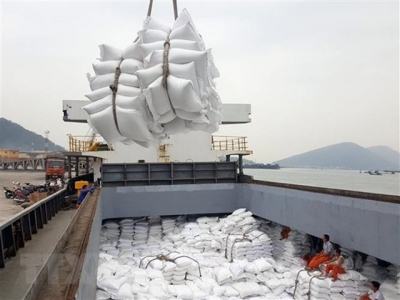Vietnamese rice exports to EU speed up

According to the Ministry of Agriculture and Rural Development, from September 4 to September 17, six enterprises appliedfor certification with a volume of approximately 4.3 thousand tonnes of fragrant rice exported to the EU. Rice exports including fragrant rice to the EU will continue to increase despite the impact of the Covid-19 pandemic from now until the end of the year.
Exports increase despite Covid-19
On September 22, at Son Lap hamlet, Vong Dong commune, Thoai Son district, An Giang, there was a ceremony to announce the export of fragrant rice shipments to the EU under the Vietnam-EU Free Trade Agreement (EVFTA). .
This batch of rice of LocTroi Group with a volume of 126 tonnes of Jasmine 85 fragrant rice, packed according to the specifications of 18kg, will be shipped to the EU market by the end of September.
The Ministry of Agriculture and Rural Development saidthe implementation of the EVFTA has created a new impetus for Vietnam's growth and international integration; especially agricultural products such as seafood, fruit, coffee and rice.
In 2019, Vietnam's rice export to the EU was 50 thousand tonnes, worth 28.5 million euro. Meanwhile, the EU's total rice imports are 2.3 million tons, worth 1.4 billion euros. Compared to other ASEAN countries, Vietnam's rice exports to the EU are only a sixth of that of Thailand, a tenth of Myanmar and a quarter of Cambodia.
In the eight months of 2020, rice exports to the EUtopped 15.8 thousand tons, with a value of approximately 8.5 million USD. However, from September 4 to September 17, six enterprises applied for certification with a volume of approximately 4.3 thousand tonnes of fragrant rice exported to the EU.
"Export rice, including fragrant rice to the EU from now to the end of the year, will continue to increase despite the impact of the Covid-19 pandemic," the Ministry of Agriculture and Rural Development said.
Around the issue of utilisingthe EVFTA to promote exports of agricultural products in general to the EU market, Minister of Agriculture and Rural Development Nguyen Xuan Cuong saidthe EVFTA is "the key" for Vietnam's agricultural exports to access into a potential market with more than511 million people andGDP per capita over 35,000 USD.
About rice, according to the EVFTA, the EU gives Vietnam a quota of 80,000 tonnes of rice each year (including 30,000 tonnes of milled rice, 20,000 tonnes of unmilled rice and 30,000 tonnes of fragrant rice). For products made from rice, the EU will bring atax rate to 0% after 3-5 years.
Reach high standards of quality
From a business perspective, Huynh Van Thin, Chairman of the Board of Directors of LocTroi Group, said that the group is aware if riceisto be exported to EU markets, itneeds to meet very high quality standards.
Since 2018, LocTroi Group has focused on investing in growing and quality control for the EU and has exported more than 10,000 tonnes of rice including Jasmine 85, Japonica DS1, OM18 andOM5451into Europewith various specifications.
From August 1, the EVFTA officially took effect, LocTroi Group prepared in seeds, growing areas, forces for the next season, working with EU partners to meet in terms of quantity, type and other requirements.
"The group aims to become one of the largest exporters to the EU in the near future by concentrating a lot of resources on reaching the EU's increasingly high quality requirements, increasing acreage areas leading to increased export output, diversifying varieties, building brand names of some varieties of Vietnam in the EU market," Huynh Van Mon said.
To exploit more opportunities from the EU market, Minister Nguyen Xuan Cuong said that the agricultural field should promote the restructuring of agricultural production in chains, of which, there is a close link between cooperatives businesses with farmers; forming a closed processing from material organisationto processing, ensuring traceability, food safety and paying attention to packaging and labels.
The Ministry of Agriculture and Rural Development always supports businesses and localities to build production chains to create quality and safe products.
Localities and businesses need to identify Vietnam's strong, complementary commodity groups to focus on boosting exports to the EU, such asseafood, coffee, cashew, pepper, wood and woodproducts and both of fresh and processed fruits, rice are the main export products to the EU; increase processing to create added value.
"Enterprises need to work closely with the State and farmers to ensure export conditions such as origin of goods, labels, food safety, and traceabilityto expand to the EU market”, the head of the agricultural industry said.
Related news
 Vietnam’s Jan-Sept coffee exports drop 1.4%, rice down 0.6%
Vietnam’s Jan-Sept coffee exports drop 1.4%, rice down 0.6% Vietnam's coffee exports in the first nine months of this year are expected to show a 1.4% drop from a year earlier to 1.25 million tonnes
 Agricultural sector needs impulse for sustainable development
Agricultural sector needs impulse for sustainable development For many years, the production of key agricultural products in the Central Highlands, such as coffee, black pepper, rubber, vegetables, and flowers
 Opportunities await sugarcane farmers if they change their way of thinking
Opportunities await sugarcane farmers if they change their way of thinking While many people believe that sugarcane farmers will face difficulties after Việt Nam implements the ASEAN Trade In Goods Agreement (ATIGA)